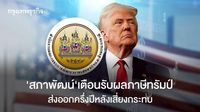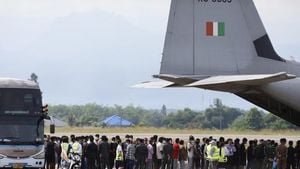Thailand is grappling with its highest inflation rate in over a decade, as official figures released on August 21, 2025, reveal a sharp rise to 7.6%. This surge, the steepest since 2011, has been attributed primarily to escalating food and energy prices, according to both government data and economic analysts cited in pulse.mk.co.kr and Bangkok Biz News.
The inflation rate for the first 20 days of August 2025 stood at 3.55%, with core inflation—a measure that strips out volatile food and energy prices—recorded at 2.45%. These numbers, though already significant, fell short of capturing the full extent of the price pressures felt by Thai households and businesses. The government had initially forecasted inflation for the period at 5.9%, but the actual rate exceeded expectations, reflecting deeper economic challenges.
"The inflation rate of 7.6% is the highest in 14 years since 2011," a government spokesperson confirmed, underscoring the gravity of the current economic environment. The report, published on August 21, 2025, details how the increase is largely driven by climbing costs in the food and energy sectors—two essentials that hit consumers hardest.
For many Thais, the rising cost of living has become a daily reality. Food prices, already on an upward trend, have jumped further due to supply chain disruptions and increased input costs. Meanwhile, energy costs have soared, partly due to global market volatility and partly because of local factors, such as currency fluctuations and regulatory changes.
In a year marked by economic uncertainty, these inflationary pressures are compounding other challenges, including the ongoing impact of international trade dynamics. The United States, one of Thailand’s major trading partners, has implemented a series of new tariff measures affecting a range of exports from Thailand and neighboring countries. According to Bangkok Biz News, the National Economic and Social Development Council (NESDC) of Thailand has warned that these U.S. tariff hikes could pose significant risks to Thai exports in the second half of 2025.
Danucha Pichayanan, Secretary-General of the NESDC, addressed the issue directly, stating, "The 19% tariff rate is forcing Thai businesses to adapt quickly, especially regarding export regulations, because U.S. trade barriers remain uncertain and could increase further." He went on to explain that the targeted tariffs—particularly those aimed at the automotive sector and related parts, which could climb as high as 25%—are expected to impact the Thai economy through three main channels.
First, there’s the direct effect on Thai exports, especially in the latter half of the year, as demand from the U.S. may decline following a surge in imports earlier in 2025. High-risk product categories include electronics, computers, and auto parts. Second, the knock-on effects on the supply chain are significant, as reduced demand for intermediate goods and raw materials—such as automotive parts, chemicals, rubber products, and plastic pellets—ripples through the region, particularly in sectors linked to China, which is also facing trade barriers. Third, there’s the risk from accelerated imports, especially goods involved in transshipment and those attempting to circumvent tariffs, which could face U.S. duties as high as 40%.
To address these mounting challenges, the NESDC has outlined a four-pronged strategy. The first recommendation is to diversify export markets, reducing reliance on the U.S.—especially for high-risk goods like phones, computers, transformers, automotive equipment, and air conditioners. This includes accelerating free trade agreement (FTA) negotiations and exploring opportunities in emerging markets. Second, the council urges stricter enforcement of rules of origin and improvements in the certification process for goods, aiming to clarify regional value content calculations and reduce costs for the private sector.
The third pillar involves cracking down on dumping and illegal trade practices, with enhanced inspections for imported goods, the establishment of comprehensive product standards, and penalties for smuggling along border areas. The NESDC also recommends supporting businesses that need to implement anti-dumping and countervailing measures. Finally, the council stresses the importance of managing exchange rate risks and cutting export-related costs to bolster Thai exporters’ competitiveness on the global stage.
While these policy responses are being developed, the data paints a complex picture. In the first 20 days of August 2025, Thailand’s export performance showed both resilience and vulnerability. According to pulse.mk.co.kr, South Korea—a regional peer—saw its exports grow by 7.6% during the same period, buoyed by semiconductors and automobiles, even as its exports to the U.S. dipped due to new tariff measures. In contrast, Thailand’s export sector is facing more pronounced headwinds, with analysts noting that some exporters have rushed shipments ahead of anticipated U.S. tariffs.
Breaking down the trade data, exports of semiconductors from South Korea increased by 29.5%, passenger vehicles by 21.7%, and ships by 28.9%. However, exports of petroleum products and wireless communication equipment dropped. For Thailand, the sectors most at risk from U.S. tariffs include electronics, automotive parts, and related intermediate goods—precisely the areas where export growth is crucial for economic recovery.
On the import side, Thailand has also seen shifts. Imports of semiconductors, gas, and machinery have increased, reflecting ongoing industrial demand and efforts to maintain supply chains. However, crude oil and petroleum product imports have declined, likely due to both price effects and adjustments in sourcing strategies.
With exports outpacing imports, Thailand recorded a trade surplus of $800 million for the period, a rare bright spot amid the inflationary gloom. Still, the overall economic outlook remains clouded by uncertainty, with policymakers and business leaders alike warning of further volatility ahead.
The inflation spike has also raised questions about the government’s ability to manage price stability. The gap between the forecasted 5.9% inflation and the actual 7.6% rate has prompted calls for more proactive measures. Economists suggest that targeted subsidies, especially for food and energy, may be needed to cushion vulnerable populations. At the same time, there’s growing debate about whether monetary policy should be tightened to rein in inflation—even if it risks slowing growth.
As Thailand navigates these turbulent waters, the country’s economic managers are under pressure to strike a delicate balance: supporting exporters amid global trade tensions, curbing inflation without stifling recovery, and ensuring that the benefits of growth reach all segments of society. The coming months will test both the resilience of the Thai economy and the effectiveness of its policy toolkit.
For now, Thai households and businesses are bracing for more tough choices, as the twin forces of inflation and global trade uncertainty continue to shape the nation’s economic future.





